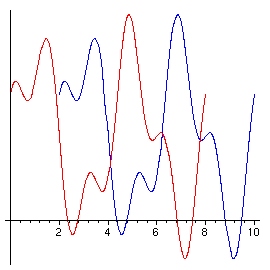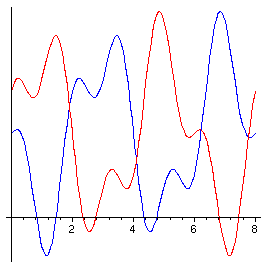
The blue graph is a copy of the red graph, displaced 2 units to the right.

Row row row your boat Gently down the stream Merrily merrily merrily merrily Life is but a dream.In one kind of performance, the second voice starts at the beginning of the third measure, when the first voice reaches "Gently," so one hears:
(Voice 1) Gently down the stream Merrily merrily merrily merrily (Voice 2) Row row row your boat Gently down the streamThe two voices continue; Voice 1 starts over when it gets to the end.
(Voice 1) Life is but a dream. Row row row your boat (Voice 2) Merrily merrily merrily merrily Life is but a dream.and so on. The canon naturally recycles.
A canon is musical when the two voices harmonize. It is an appealing form, because it gives a very easy introduction to part-singing: there is only one melody to learn, but the harmonies that come from the play of one voice against the other can be very pleasing.
Mathematically speaking, the operation that produces Voice 2 from Voice 1 is a translation in time. If the pitch sequence that describes the melody for Voice 1 is represented by a function f(t), and if we let t represent number of measures, then Voice 2 would be represented by the function g(t) = f(t-2). So for example at the beginning of the third measure (time t = 2), the pitch of Voice 2 would be g(2) = f(0), the pitch of Voice 1 at the beginning (time t = 0).
The translation operation that makes g out of f is
studied in an Elementary Functions course, because it is one of the
important ways of making new functions out of old, or of tailoring a
given function to fit a new situation.
Here is a typical example:
 |
The red graph represents a function f(t), the
blue graph is The blue graph is a copy of the red graph, displaced 2 units to the right. |
 |
The red graph represents a periodic function f(t), of period 8;
the
blue graph is
|